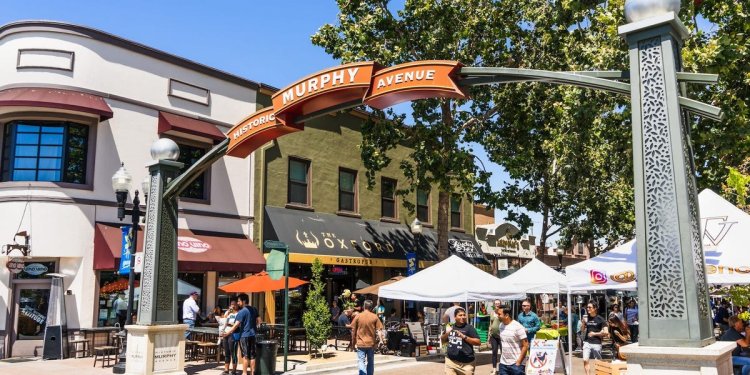The 15 US cities where your money goes the furthest
A recent analysis focused on renters shows where their money can go the furthest. Sunnyvale in California ranked No. 1.

Sundry Photography/Shutterstock
- An analysis from RentCafe indicated how far renters' income can go in 189 US places.
- RentCafe ranked cities based on income, rent, and expenses, including food.
- Sunnyvale, CA, had the highest score and the largest monthly income among the places in the analysis.
Sunnyvale, California, has over 150,000 people, multiple parks, a Google campus, Lockheed Martin work opportunities, and also hosts the headquarters of job search and networking platform LinkedIn.
This city is also where renters can see their money go the furthest among 189 places in a recent analysis from RentCafe.
A financial balance score was calculated for 189 US cities, which was then used to rank these places. The overall score for the ranking wasn't simply about how rent compares to someone's income. Some other expenses people need to pay were accounted for, such as healthcare, transportation, and food. While rent was based on Yardi Matrix, which does research on various types of real estate, other expenses were based on the Council for Community and Economic Research. Income was based on Census Bureau data.
A RentCafe blog post stated that "to obtain the ratios used in the score for each category in each city, we calculated the disposable income left after paying the monthly rent. We then aggregated the price per unit for each of the cost of living products and services and calculated the ratio between income and total cost per category."
Doug Ressler, manager of business intelligence at Yardi Matrix, told Business Insider the overall score "was based on the sum of all" weighted category scores. Some categories had a larger weight than others; the income-to-rent ratio had the largest weight, for instance.
You can hover over each city in the chart below to see the values from RentCafe that were shared with BI, including each city's overall score. The overall score is also seen by the size of each point.
As seen in the chart, looking just at monthly renter household income compared to monthly rent and basic necessities together, many of the places looked at had ratios around 1. That is, incomes weren't too far off from expenses.
RentCafe found Athens, Georgia; New Orleans; Albany, New York; and Gainesville, Florida, had some of the lower scores among the places examined. They all had scores that were less than 18, meaning they are among the locations where renters might not be able to get a lot out of their income.
Auburn, Alabama, had a score far lower than the other places, with a score of 1.59. Its monthly income was $1,880. Rent and the various expenses together had a value of $2,585 for this location.
While Sunnyvale didn't have the largest monthly rent and basic necessities value together, it did have the highest monthly renter household income among the 189 US cities part of the analysis. Its monthly income was more than $12,000. Its rent is around a quarter of that, at around $3,000 a month per the blog post.
The post from RentCafe writer Alexandra Both that highlighted the analysis stated that "in the heart of Silicon Valley, renters had the highest annual wages in the country — triple the nation's median income." The post noted $49,201 as the median for renters.
Meanwhile, Both wrote that "Boston had similar prices for basic necessities" as well as "a slightly higher monthly rent" than for Sunnyvale. However, Both added "its lower annual income of just less than $61,000 would make budgeting more challenging for renters." Boston's score based on the methodology was 8.85.
Manhattan had the largest monthly rent plus basic necessities value but ended up having one of the lower scores, at 14.73. Its monthly renter household income was only around a $500 difference from rent and basic necessities analyzed, or $6,477 compared to $5,965.
Based on the scores calculated using income, rent, and expenses data, three of the top 15 cities where income can go far were in Texas, with scores near or over 60.0. Two of the top 5 cities were in Virginia, with scores not too far from or greater than 70.0.
What the rental market looks like and may look like this year
Meanwhile, Ressler noted the attractiveness of city hubs is partly behind why there could be a lot of the supply coming in those areas.
"The coastal cities, the gateway cities have always been hubs for greater density," Ressler said. "With greater density, you have more population, you have more population demand for supply of rental housing."
Overall, Ressler said "the rental market is continuing to be dynamic" and renters could see some relief as new buildings come online.
"What we're seeing in most of the major cities is a deceleration of rent," Ressler said, adding this "is based on the incoming new supply."
"We also anticipate that there will be concessions that are being offered in most major markets to retain renters because there's also a cost of replacing a renter once they've moved out," Ressler said.
Outside of renting, people eager to close on a home may be finding it's hard to find affordable options. Ressler said there's been years of "inadequate, affordable housing stock" available to buy.
"It will take another decade to try and work our way out of providing housing stock for folks to be able to buy and purchase their own homes," Ressler said if this continues to occur.
Ressler's advice for renters in general is to make sure to do research in three main categories: live, work, and play. For instance, aspiring renters might need to think about parking and transportation access where they want to rent.
How does your income compare to rent and other expenses? Reach out to this reporter to share at [email protected].
What's Your Reaction?




















